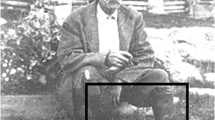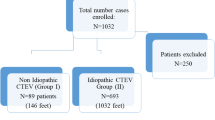Abstract
Idiopathic clubfoot is one of the most common problems in paediatric orthopaedics. The treatment is controversial and continues to be one of the challenges in paediatric orthopaedics. The aim of this review is to assess the different methods of clubfoot treatment used over the years in light of the documentation present in the literature and art paintings from the antiquity to the end of the 19th century. The aim of this paper is to review all treatment methods of the clubfoot over the years that were proposed to provide patients a functional, pain-free, normal-looking foot, with good mobility, without calluses, and requiring no special shoes. Hippocrates was the first to write references about treatment methods of clubfoot. After the Middle Ages and the Renaissance where patients were treated by barber-surgeons, quacks and charlatans, bonesetters, and trussmakers, there were more detailed studies on the disease, with the help of famous names in medicine such as Venel and Scarpa.

















Similar content being viewed by others
References
Smith EG, Warren RD (1924) Egyptian mummies. Allen and Unwin, London
Bartsocas CS (1972) Hephaestus and clubfoot. Hist Med Allied Sci 27:450–451
Fitzgerald R (trans) (1930) Homer Use Odyssey. Garden City Publishers, New York, pp 144–149
Hippocrates (1939) In: Adams F (ed) The genuine works of Hippocrates, trans. Williams & Wilkins Co., Baltimore, pp 254–255
Hernigou P (2014) Crutch art painting in the Middle Ages as orthopaedic heritage (part I: the lepers, the poliomyelitis, the cripples). Int Orthop 38(6):1329–1335
Hernigou P (2014) Crutch art painting in the Middle Ages as orthopaedic heritage (part II: the peg leg, the bent-knee peg and the beggar). Int Orthop 38(7):1535–1542
Malgaigne JF (1840) Oeuvres completes d’Ambroise Pare. Paris
Hernigou P (2013) Ambroise Paré’s life (1510-1590): part I. Int Orthop 37(3):543–547
Price R (1979) Spanish medicine in the golden age. J R Soc Med 72:864–874
Arcaeus F (1674) Chirurgische Bucher. Nuremberg
Fallopio G (2008) Complete dictionary of scientific biography. Scribner, Detroit, pp 519–521
FalIoppio G (1606) Opere genuine omnia. Venice
Fabricius ab Aquapendente H (1592) Opera cirurgica. Frankfurt
No Author (1966) Fabricius ab Aquapendente (1537–1619) preceptor of Harvey. JAMA 198:178–179
Rosenberg SL (1933) Hieronymus Fabricius ab Aquapendente: Part I. Calif West Med 38:173–176
Wurtz F (1616) Bin schoenes und nutzliches Kinderbuchlein. S. Flenricpetri, Basel
Jones E (1960) The life and works of guilhelmus fabricius hildanus (1560–1634): part I. Med Hist 4(2):112–134
Jones E (1960) The life and works of guilhelmus fabricius hildanus (1560–1634): part II. Med Hist 4(3):196–209
Cheselden W (1740) The anatomy of the human body, 5th edn. London
Grosch G (1975) Jean-Andre Venel (1740-1791) und die Begriindung der klassichen Orthopadie. Cesnerus 32:192–199
Valentin B (1956) Jean-Andre Venel, der Vater der Orthopadie. Sudhoffs Archiv 40:305–336
Bruckner KAF (1795) Uber einwarts gedrehte Fiisse und deren Behandlung. J. Erfindungen, Theorien und Widerspriiche in d. Natur- und Arznei Wissenschaft 3(12):35
Scarpa A (1803) Memoria chirurgica sui piedi torti congeniti dei fanciulli, e sulla maniem di correggere questa defomita, 2d edn. Baldassare Comino, Pavia
Scarpa A (1806) Memoria chirurgica sui piedi torti dei fanciulli e sulla maniera di correggere questa deformità. Pavia
Scarpa A (1818) A memoir on the congenital club feet and of the mode of correcting that deformity. Trans. J. H. Wishart (ed), Archibald Constable and Co., Edinburgh, p 8–9
van der Haar J (1797) Uitgezochte genees- en keelkundige Mengelscriften. Amsterdam
Bouvier J (1858) Leçons cliniques sur les maladies chroniques de l’appareil locomoteur. Paris
Hernigou P (2016) Plaster of Paris: the orthopaedic surgeon heritage. Int Orthop 40(8):1767–1779
Guerin C (1876) Memoire sur l’etiologie generale des pieds-bots congenitales. Paris
Blumenkamp C (1853) Eenige waarnerningen vanbehandelnde beenbreuken met her gipsverband, vol 18. Courant, Geneesk
Michaux M (1856) Considerations sur les pieds-bots poplitees internes. Bull Acad Med Belg 15:447
Sheldrake T (1798) A practical essay on the club-foot and other distortions in the legs and feet of children. London
Cameron HC (1923) The mystery of Lord Byron’s lameness. Lancet 1:678–679
Lockhart JG (1887) The Life of Sir Walter Scott, Bart. Carey, Lea & Blanchard, Philadelphia, 1:23–27
Lacheretz M (1986) Un cas méconnu de syndrome de Marfan: celui de Talleyrand. Bull Acad Natle Med 170:1033–1040
Lacheretz M (1987) Le pied bot de Talleyrand. Etiologie et considérations génétiques. Chirurgie 113:148–153
Lord Byron (1964) The poetical works of Lord Byron. Oxford University Press, New York, p 605
Author information
Authors and Affiliations
Corresponding author
Ethics declarations
Conflict of interest
The authors declare that they have no conflict of interest.
Funding
There is no funding source.
Rights and permissions
About this article
Cite this article
Hernigou, P., Huys, M., Pariat, J. et al. History of clubfoot treatment, part I: From manipulation in antiquity to splint and plaster in Renaissance before tenotomy. International Orthopaedics (SICOT) 41, 1693–1704 (2017). https://doi.org/10.1007/s00264-017-3487-1
Received:
Accepted:
Published:
Issue Date:
DOI: https://doi.org/10.1007/s00264-017-3487-1




